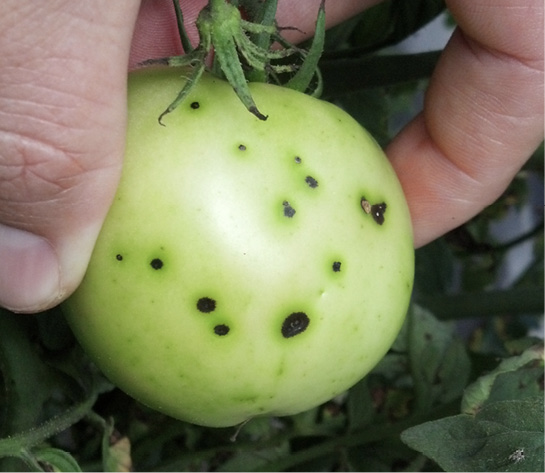Bacterial Speck and Bacterial Spot in Tomatoes
Bacterial speck and spot are common bacterial diseases of tomatoes in the southeastern United States.
Signs and Symptoms
Symptoms of bacterial speck can occur on leaves, stems, petioles, peduncles, pedicels, sepals, and fruit. Round, dark-brown to black lesions develop on leaves infected with the bacterial speck pathogen; over time, a yellow halo may develop around leaf lesions (Figure 1). These lesions extend to both leaf surfaces but are more prominent on the lower leaf surface. Lesions on stems, petioles, peduncles, pedicels, and sepals tend to be more elongated. Small, dark lesions that are commonly flat or slightly raised develop on infected fruits; as fruits enlarge, these lesions become sunken or pitted (Figure 2). A dark green halo may also develop around fruit lesions (Figure 2).
Symptoms of bacterial spot also can develop on all aboveground plant parts. Brown, circular lesions develop on leaves, stems, and fruit spurs. The tissue surrounding lesions on leaflets may become chlorotic (yellow) (Figure 3). In some bacterial spot infections, leaves may have a shot-hole appearance. As lesions coalesce, the foliage becomes blighted and may defoliate or remain attached to the plant. Lesions on fruits begin as small, slightly raised blisters that grow and become scab-like (Figures 4 and 5). Bacterial spot can also occur on peppers, and symptoms on peppers are similar to those observed in tomatoes (Figures 6 and 7).
In both bacterial speck and spot, lesions may coalesce to kill large areas of leaf tissue or cause streaking. Fruit lesions of bacterial spot tend to be rough compared to those of bacterial speck. However, the symptoms of bacterial speck and spot are very similar and may easily be confused with one another. Pathogen isolation and laboratory testing are often necessary to confirm a diagnosis. Symptoms associated with bacterial speck and spot on leaflets may also be confused with other diseases of tomatoes, such as early blight, gray leaf spot, and target spot.

Photo: Gerald Holmes, Cal Poly – San Luis Obispo, Bugwood.org.

Photo: Gary E. Vallad, University of Florida, IFAS.

Photo: David B. Langston, University of Georgia, Bugwood.org.

Photo: Ed Sikora, Auburn University, Bugwood.org.

Photo: R. W. Samson, Purdue University, Bugwood.org.

Photo: Gerald Holmes, Cal Poly – San Luis Obispo, Bugwood.org.

Photo: Howard F. Schwartz, Colorado State University, Bugwood.org.
Pathogen and Disease Spread
Bacterial speck is caused by the bacterium Pseudomonas syringae pv. tomato. This pathogen is seedborne and can overwinter in crop residue in temperate climates. Disease development is favored by high humidity and temperatures between 64°F and 75°F.
Bacterial spot is caused by several species of Xanthomonas: X. vesicatoria, X. euvesicatoria, X. gardneri, and X. perforans. Xanthomonas perforans has been confirmed on tomatoes in Mississippi (Abrahamian et al., 2017). These pathogens can be spread by seed and can overwinter in crop residue. Disease development is favored by high precipitation, high humidity, and temperatures between 75°F and 86°F.
The bacterial speck and bacterial spot pathogens can be spread easily during transplant production in greenhouses when plants are densely grown and watered overhead. These bacteria may survive on the surface of transplants without causing disease. These pathogens may also be spread by splashing water and wind-driven rain and on tools, machinery, and workers’ hands. The bacteria enter plants through natural openings and wounds. Volunteer tomatoes and, in the case of bacterial spot, peppers can serve as sources of inoculum.
Management
Though it can be difficult to distinguish between bacterial speck and spot in tomatoes, the management practices for the diseases are very similar.
Biological Management
Plant resistant varieties. Varieties with resistance/tolerance to the bacterial speck pathogen are available. Check the latest edition of the Southeastern U.S. Vegetable Crop Handbook for resistant varieties that may be recommended for Mississippi. Varieties resistant to the bacterial spot pathogen are not currently available. Growers planting both tomatoes and peppers, however, can purchase and plant varieties of peppers that have resistance to the bacterial spot pathogen.
Cultural Management
Avoid overhead irrigation/watering and overwatering of transplants. The bacterial speck and spot pathogens can be spread easily in the greenhouse when plant density is high and plants are watered overhead. Minimize overwatering of transplants in the greenhouse and overhead watering when possible.
Avoiding excessive handling of transplants. Bacteria can easily be spread on tools and on workers’ hands. Avoid handling transplants more than necessary, especially when wet.
Choose, prepare, and maintain an appropriate field for planting. Plant tomatoes in soil that drains well. Remove volunteer tomatoes and peppers from fields before planting and during crop rotation years when non-host crops are planted.
Plow or disk fields. At the end of the season, plow or disk fields to bury crop debris.
Practice crop rotation. In fields with bacterial speck and spot, 2-year (minimum) and 1-year crop rotations, respectively, are recommended.
Sanitation
Use disease-free seeds and plants. Purchase high-quality, pathogen-free seeds from reputable seed sources.
Use effective seed treatments to treat seeds. Seeds that have not been treated by the supplier should be treated with hot water, hydrochloric acid, or sodium hypochlorite. Additional information about seed treatments is available in the latest edition of the Southeastern U.S. Vegetable Crop Handbook.
Remove and destroy infected transplants. If bacterial speck or spot is detected in transplants in the greenhouse, infected transplants as well as those in neighboring trays should be removed and destroyed.
Follow good sanitation practices when growing transplants. Wash hands after working with transplants. Regularly wash and disinfest pruning tools. Wash and sanitize tools, trays, equipment, surfaces, and greenhouse structures in between crops.
Chemical Management
Apply bactericides that are effective against bacterial speck and spot. Numerous copper-based products (FRAC Group M01) are available for use against bacterial speck and spot on tomatoes and are labeled for use in Mississippi. However, resistance to copper is known to occur in bacteria causing bacterial spot. In 2017, copper resistance was identified in populations of Xanthomonas perforans in Jasper and Smith Counties in Mississippi (Abrahamian et al., 2019). The extent and distribution of copper resistance in this pathogen in Mississippi is not known.
When pathogen resistance to copper is suspected, copper products should be tank-mixed with mancozeb (FRAC Group M05). Read the label to determine if tank-mixing a specific copper product with mancozeb is allowed. Alternatively, a product containing copper and mancozeb (FRAC Groups M01 + M05) can be applied.
Another product, acibenzolar-S-methyl (FRAC Group 21; e.g., Actigard 50WG), is available for management of bacterial speck and spot and can be applied to healthy, actively growing plants. This product should be considered if copper resistance is known or suspected, but growers should keep in mind the 14-day pre-harvest interval (PHI) of acibenzolar-S-methyl when choosing products for disease control.
Various biopesticides or fungicide alternatives are also available and labeled for use against bacterial speck and spot. See the Biopesticides, Fungicide, and Nematicide Alternatives for Vegetables table in the latest edition of the Southeastern U.S. Vegetable Crop Handbook for a list of these products.
Certain products may also be used preventively on transplants, in the greenhouse, or in organic tomato production. See the Greenhouse Disease Control for Various Vegetable Crops and the Biopesticides, Fungicide, and Nematicide Alternatives for Vegetables tables in the latest edition of the Southeastern U.S. Vegetable Crop Handbook for more information. Carefully read product labels and check with your organic certifier, when applicable, to ensure that a particular product is allowed in your particular production system.
When using fungicides, remember: the label is the law. You must completely read and understand product labels before use, and you must follow the label.
References
Abrahamian, P., Klein, J. M., Jones, J. B., Vallad, G. E., and Melanson, R. A. 2019. First report of bacterial spot of tomato caused by Xanthomonas perforans in Mississippi. Plant Disease 103(1):147.
Jones, J. B., Zitter, T. A., Momol, T. M., and Miller, S. A. (eds). 2014. Compendium of tomato diseases and pests, 2nd edition. American Phytopathological Society Press, St. Paul, MN. 168 pages.
Lewis Ivey, M. L. 2015. Common names of plant diseases: Diseases of pepper (Capsicum L.). American Phytopathological Society. Online: http://apsnet.org/publications/commonnames/Pages/default.aspx. Accessed: May 2, 2018.
Additional Resources
Choosing a Disinfectant for Tools and Surfaces in Horticultural Operations (IS1955),
http://extension.msstate.edu/publications/choosing-disinfectant-for-tools-and-surfaces-horticultural-operations
Pesticide Label Databases (P3155),
http://extension.msstate.edu/publications/publications/pesticide-label-databases
Southeastern U.S. Vegetable Crop Handbook, available at http://www.vegcrophandbook.com.
This work is partially supported by Crop Protection and Pest Management, Extension Implementation Program grant no. 2017-70006-27200/project accession no. 1014037 from the USDA National Institute of Food and Agriculture. Any opinions, findings, conclusions, or recommendations expressed in this publication are those of the author(s) and do not necessarily reflect the view of the U.S. Department of Agriculture.
The information given here is for educational purposes only. References to commercial products, trade names, or suppliers are made with the understanding that no endorsement is implied and that no discrimination against other products or suppliers is intended.
Publication 3361 (POD-03-20)
By Rebecca A. Melanson, PhD, Assistant Extension Professor, Plant Pathology, Central Mississippi Research and Extension Center.
Reviewed by Clarissa Balbalian, Diagnostic Laboratory Manager, MSU Extension; Shien Lu, PhD, Professor, Plant Pathology, MAFES; Kelby King, Jasper County ANR Extension Agent, MSU Extension; and Gary E. Vallad, Associate Professor, Plant Pathology, University of Florida, IFAS.
Copyright 2020 by Mississippi State University. All rights reserved. This publication may be copied and distributed without alteration for nonprofit educational purposes provided that credit is given to the Mississippi State University Extension Service.
Produced by Agricultural Communications.
Mississippi State University is an equal opportunity institution. Discrimination in university employment, programs, or activities based on race, color, ethnicity, sex, pregnancy, religion, national origin, disability, age, sexual orientation, genetic information, status as a U.S. veteran, or any other status protected by applicable law is prohibited. Questions about equal opportunity programs or compliance should be directed to the Office of Compliance and Integrity, 56 Morgan Avenue, P.O. 6044, Mississippi State, MS 39762, (662) 325-5839.
Extension Service of Mississippi State University, cooperating with U.S. Department of Agriculture. Published in furtherance of Acts of Congress, May 8 and June 30, 1914. GARY B. JACKSON, Director
The Mississippi State University Extension Service is working to ensure all web content is accessible to all users. If you need assistance accessing any of our content, please email the webteam or call 662-325-2262.




